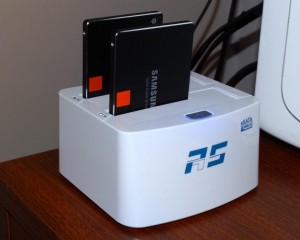 For a storage reviewer, there is no better discovery than something that cuts the time of storage reviews as most can take a week or longer. We first spoke of this in 2010 when we reviewed the Vantec External Dock which didn’t quite meet our needs.
For a storage reviewer, there is no better discovery than something that cuts the time of storage reviews as most can take a week or longer. We first spoke of this in 2010 when we reviewed the Vantec External Dock which didn’t quite meet our needs.
This report examines the HighPoint 5322 Dual eSATA 6Gbps External Dock, along with their RocketRAID 2711 6Gbps RAID card and, to promote this gear as being a game changer just may be an understatement.
The problem was simple. There needed to be a way of temporarily installing SSDs to benchmark on our systems without interrupting the system or taking too much time. Our review of the Vantec External Dock came to a quick halt as we discovered that it could not attain the speeds needed for benchmarking storage media. We eventually found RAID cages that allowed us to hot swap SSDs from the front of the system quickly and easily, however, this didn’t work in situations where we needed to test mSATA SSDs in adapters. It wasn’t until a chance stop at the HighPoint booth, while at ceBIT 2013 Germany, that we found our answer in the HighPoint 5322 Dual eSATA 6Gbps External Dock.
On display was the HighPoint 5322 Dock which was connected via SAS to 4 eSATA connector to HighPoint’s 2711 4-Port SAS 6Gbps PCIe x8 RAID Host Adapter. HighPoint swore that it could match performance listed from all of our benchmarks and challenged us by sending one within two weeks. Could we resist?
From left to right we have the HighPoint RocketStor 5322 Dual Dedicated eSATA 6Gbps Storage Dock, HighPoint Mini-SAS to 4-Port eSATA connector and the well established RocketRAID 4-Port SAS 6Gbps PCIe 2×8 RAID Host Adapter. The RocketStor 5322 is an industry first by the way. On the back, it contains two 6Gbps eSATA ports for a combined total of 12Gbps and the ability to do some great RAID testing as well. AS shown in our featured shot, two Samsung 840 Pro 512GB SATA 3 SSDs were chosen for the task.

 The RocketRAID 2711 6Gbps Host Adapter is made for RAID first and foremost. It is capable of configuring RAID 0, 1, 5, 10 and JBOD support, along with single disk setup. The question would be whether it’s SATA 3 speeds could reach the logical maximum that we typically see in our reviews.
The RocketRAID 2711 6Gbps Host Adapter is made for RAID first and foremost. It is capable of configuring RAID 0, 1, 5, 10 and JBOD support, along with single disk setup. The question would be whether it’s SATA 3 speeds could reach the logical maximum that we typically see in our reviews.
The connection from the cable to the card is mini-SAS. Installation requires software that, not only installs a driver for hardware recognition but also, it enables setup of the HighPoint RAID Management GUI which we found to be one of the easiest we have used yet in quickly establishing a RAID volume.
Right from the outset though, there was something that we didn’t like about this configuration. On boot, the RocketRAID 2711 bios initialized by searching for storage devices, creating a 15-20 second increase in our start up time. This wasn’t good as the TSSDR Test Bench typically starts in 15 seconds. We contacted HighPoint, explaining that we wanted to simply hot swap drives in and out of the dock to which they sent an amended bios within a day. Installation of the bios through the GUI was quick and easy and, once installed, initial boot of the system and RocketRAID 2711 resulted in no noticeable start time increase.
 The SSD Review The Worlds Dedicated SSD Education and Review Resource |
The SSD Review The Worlds Dedicated SSD Education and Review Resource | 
This is AWESOME! I’ve been an SSD freak ever since the X25-M G1 and I currently run two 240GB Intel 520 Series SSD’s in RAID 0 in a late-2012 Mac mini. I’m getting 850MB/s reads and just under 500MB/s writes using the Blackmagic speed test utility. Is there a way to get this to work with Macs? Through a Thunderbolt port perhaps?
NO. The only similar solution we found was the OWC Helios which is a TBolt external that a PCIe fits in. We reached 900MB/s in testing that during our review.